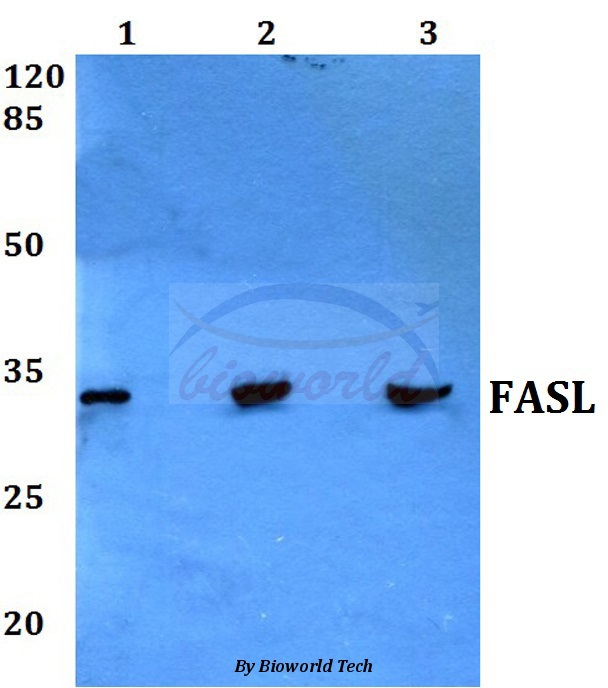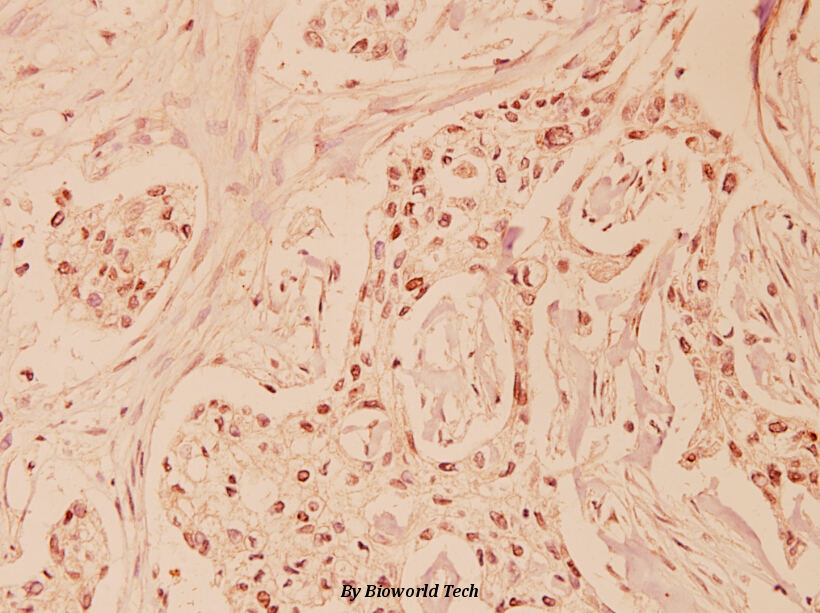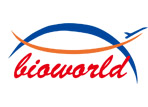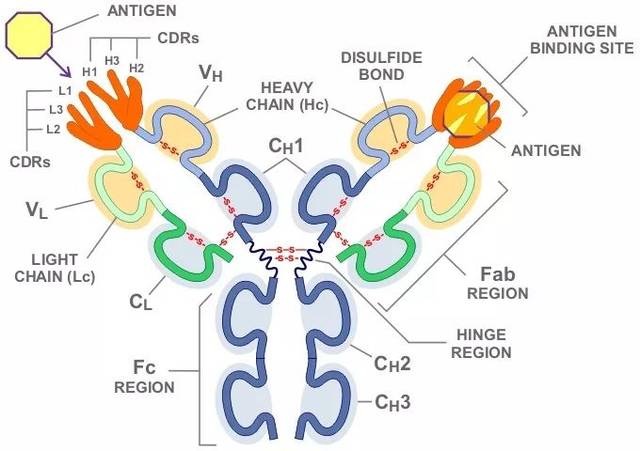Product Name :
FasL (P137) polyclonal antibody Background :
Cytotoxic T lymphocyte (CTL)-mediated cytotoxicity constitutes an important component of specific effector mechanisms in immuno-surveillance against virus-infected or transformed cells. Two mechanisms appear to account for this activity, one of which is the Perforin-based process. Independently, a FASbased mechanism involves the transducing molecule FAS (also designated Apo-1) and its ligand (FAS-L). The human FAS protein is a cell surface glycoprotein that belongs to a family of receptors that includes CD40, nerve growth factor receptors and tumor necrosis factor receptors. The FAS antigen is expressed on a broad range of lymphoid cell lines, certain of which undergo apoptosis in response to treatment with antibody to FAS. These findings strongly imply that targeted cell death is potentially mediated by the intercellular interactions of FAS with its ligand or effectors, and that FAS may be critically involved in CTL-mediated cytotoxicity. Product :
Rabbit IgG, 1mg/ml in PBS with 0.02% sodium azide, 50% glycerol, pH7.2 Storage&Stability :
Store at 4°C short term. Aliquot and store at -20°C long term. Avoid freeze-thaw cycles. Specificity :
FAS ligand/TNFL6 (P137) polyclonal antibody detects endogenous levels of FAS ligand/TNFL6 protein. Immunogen :
Synthetic peptide, corresponding to amino acids 100-150 of Human FasL. Conjugate :
Unconjugated Modification :
Unmodification
FasL (P137) polyclonal antibody Background :
Cytotoxic T lymphocyte (CTL)-mediated cytotoxicity constitutes an important component of specific effector mechanisms in immuno-surveillance against virus-infected or transformed cells. Two mechanisms appear to account for this activity, one of which is the Perforin-based process. Independently, a FASbased mechanism involves the transducing molecule FAS (also designated Apo-1) and its ligand (FAS-L). The human FAS protein is a cell surface glycoprotein that belongs to a family of receptors that includes CD40, nerve growth factor receptors and tumor necrosis factor receptors. The FAS antigen is expressed on a broad range of lymphoid cell lines, certain of which undergo apoptosis in response to treatment with antibody to FAS. These findings strongly imply that targeted cell death is potentially mediated by the intercellular interactions of FAS with its ligand or effectors, and that FAS may be critically involved in CTL-mediated cytotoxicity. Product :
Rabbit IgG, 1mg/ml in PBS with 0.02% sodium azide, 50% glycerol, pH7.2 Storage&Stability :
Store at 4°C short term. Aliquot and store at -20°C long term. Avoid freeze-thaw cycles. Specificity :
FAS ligand/TNFL6 (P137) polyclonal antibody detects endogenous levels of FAS ligand/TNFL6 protein. Immunogen :
Synthetic peptide, corresponding to amino acids 100-150 of Human FasL. Conjugate :
Unconjugated Modification :
Unmodification
-
 Western blot (WB) analysis of FASL (P137) polyclonal antibody at 1:500 dilution Lane1:Hela whole cell lysate Lane2:NIH-3T3 whole cell lysate Lane3:PC12 whole cell lysate
Western blot (WB) analysis of FASL (P137) polyclonal antibody at 1:500 dilution Lane1:Hela whole cell lysate Lane2:NIH-3T3 whole cell lysate Lane3:PC12 whole cell lysate -
 Immunohistochemistry (IHC) analyzes of FasL (P137) pAb in paraffin-embedded human breast carcinoma tissue at 1:100.
Immunohistochemistry (IHC) analyzes of FasL (P137) pAb in paraffin-embedded human breast carcinoma tissue at 1:100.
miR-181a increases FoxO1 acetylation and promotes granulosa cell apoptosis via SIRT1 downregulation
PMCID: Pubmed No.:28981116
Neferine inhibits cultured hepatic stellate cell activation and facilitates apoptosis: A possible molecular mechanism
PMCID: Pubmed No.:20969858
Targeted mutation of Fas ligand gene attenuates brain inflammation in experimental stroke
PMCID: Pubmed No.:21802508
NF-κB, JNK and p53 pathways are involved in tubeimoside-1–induced apoptosis in HepG2 cells with oxidative stress and G2/M cell cycle arrest
PMCID: Pubmed No.:22005259
Methylated actinomycin D, a novel actinomycin D analog induces apoptosis in HepG2 cells through fas- and mitochondria-mediated pathways†
PMCID: Pubmed No.:22821714
Hyperbaric Oxygen Suppresses Hypoxic-Ischemic Brain Damage in Newborn Rats
PMCID: Pubmed No.:24762865
MiR-21 regulates N-methyl-N-nitro-N′-nitrosoguanidine-induced gastric tumorigenesis by targeting FASLG and BTG2
PMCID: Pubmed No.:24821435
Phenethyl isothiocyanate enhances adriamycin‑induced apoptosis in osteosarcoma cells
PMCID: Pubmed No.:26252906
iTRAQ-based quantitative proteomic analysis of the anti-apoptotic effect of hyperin, which is mediated by Mcl-1 and Bid, in H2O2-injured EA. hy926 cells
PMCID: Pubmed No.:26935776
iTRAQ-based quantitative proteomic analysis of the anti-apoptotic effect of hyperin, which is mediated by Mcl-1 and Bid, in H2O2-injured EA. hy926 cells
PMCID: Pubmed No.:26935776
Hyperbaric Oxygen Suppresses Hypoxic-Ischemic Brain Damage in Newborn Rats
PMCID: Pubmed No.:24762865
MiR-21 regulates N-methyl-N-nitro-N′-nitrosoguanidine-induced gastric tumorigenesis by targeting FASLG and BTG2
PMCID: Pubmed No.:24821435
Prognostic Investigations of Expression Level of Two Genes FasL and Ki-67 as Independent Prognostic Markers of Human Retinoblastoma
PMCID: Pubmed No.:27625332
The reproductive toxicology of male SD rats after PM2.5 exposure mediated by the stimulation of endoplasmic reticulum stress
PMCID: Pubmed No.:28961540
iTRAQ-based quantitative proteomic analysis of the anti-apoptotic effect of hyperin, which is mediated by Mcl-1 and Bid, in H2O2-injured EA.hy926 cells
PMCID: Pubmed No.:26935776
Phenethyl isothiocyanate enhances adriamycin‑induced apoptosis in osteosarcoma cells
PMCID: Pubmed No.:26252906
Protective Efficacy of Vitamins C and E on p,p′-DDT-Induced Cytotoxicity via the ROS-Mediated Mitochondrial Pathway and NF-κB/FasL Pathway
PMCID: Pubmed No.:25464339
Isoflurane Damages the Developing Brain of Mice and Induces Subsequent Learning and Memory Deficits through FASL-FAS Signaling
PMCID: Pubmed No.:26609525
Saponin 6 derived from Anemone taipaiensis induces U87 human malignant glioblastoma cell apoptosis via regulation of Fas and Bcl‑2 family proteins
PMCID: Pubmed No.:27175997
Soluble epoxide hydrolase (Ephx2) silencing attenuates the hydrogen peroxide-induced oxidative damage in IEC-6 cells
PMCID: Pubmed No.:34336035
Over-Expression of ATPase II Alleviates Ethanol-Induced Hepatocyte Injury in HL-7702 Cells
PMCID: Pubmed No.:30457983
Bioworld Biotech only provide peptides for our antibodies and do not provide additional peptide customization services.
Price/Size :
USD 368/1mg/vial
Tips:
For phospho antibody, we provide phospho peptide(0.5mg) and non-phospho peptide(0.5mg).Describe :
Blocking peptides are peptides that bind specifically to the target antibody and block antibody binding. These peptide usually contains the epitope recognized by the antibody. Antibodies bound to the blocking peptide no longer bind to the epitope on the target protein. This mechanism is useful when non-specific binding is an issue, for example, in Western blotting (WB) and Immunohistochemistry (IHC). By comparing the staining from the blocked antibody versus the antibody alone, one can see which staining is specific; Specific binding will be absent from the western blot or IHC performed with the neutralized antibody.Formula:
Synthetic peptide was lyophilized with 100% acetonitrile and is supplied as a powder. Reconstitute with 0.1 ml DI water for a final concentration of 10 mg/ml.The purity is >90%,tested by HPLC and MS.
Storage:
The freeze-dried powder is more stable. For short time at 2-8°C. For long term storage store at -20°C.
Note :
This product is for research use only (RUO only). Not for use in diagnostic or therapeutic procedures.
 FasL (P137) polyclonal antibody
FasL (P137) polyclonal antibody  Datasheet
Datasheet COA
COA MSDS
MSDS SHIP
SHIP